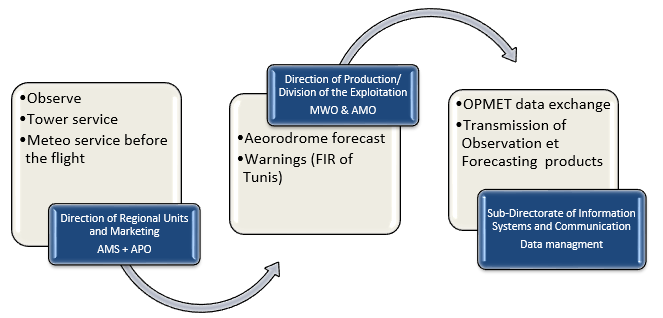Organization and mission of the National Institute of Meteorology (NIM) for meteorological service for air navigation:
The objective of meteorological service for air navigation is to contribute towards the safety, regularity and efficiency of international air navigation. This objective shall be achieved by supplying the following users: operators, flight crew members, air traffic services units, search and rescue services units, airport managements and others concerned with the conduct or development of international air navigation, with the meteorological information necessary for the performance of their respective functions.
This meteorological service for air navigation is provided as defined in the provisions of the following regulatory references:
- Decision of the transport minister No. 09 of 18 January 2019 on the designation of the meteorological authority responsible for the provision of meteorological service for international air navigation in the TUNIS flight information region.
- Decision of the transport minister No. 67 of 11 February 2017 on meteorological service for air navigation.
- The letter of agreement between the National Institute of Meteorology (NIM) and the Civil Aviation and Airports Office (CAAO), including its annexes.
All established pursuant to the provisions of the WMO technical regulation No. 49 and those of Annex 3 of the Chicago Convention on International Civil Aviation.
These missions are ensured by the following functional organization:

Meteorological service for air navigation in Tunisia is ensured by the following organizations:
- Meteorological watch office (MWO).
- Central aerodrome meteorological office, supported by aeronautical protection offices installed at each airport.
- Aeronautical meteorological station.
Meteorological watch office:
In Tunisia, only one meteorological watch office is attached to the only flight information region (FIR), the one of Tunis. The functions of this meteorological watch office are ensured by the Aeronautical Forecasting Service of the Division of the Exploitation, which is part of the Direction of Production.
Aerodrome meteorological office:
In Tunisia, the aerodromes do not have an aerodrome meteorological office on site but they have an aeronautical protection office and are all attached to only one aerodrome meteorological office designated to ensure meteorological service required to meet the needs of international air navigation at each airport.
This office carries the International Civil Aviation Organization (ICAO) code for the Tunis Carthage airport “DTTA” and is housed in the aeronautical forecasting service. The aerodrome meteorological office and the aeronautical protection office share the responsibilities related to the needs of users.
Aeronautical protection office:
At each aerodrome, the NIM has an aeronautical protection office, which is under the authority of the regional unit which it belongs and in close collaboration with the home aerodrome meteorological office.
Aeronautical meteorological station:
The NIM has a number of aeronautical weather stations. These stations will make routine hourly or semi-hourly observations.
At aeronautical meteorological stations at aerodromes, the routine observations are supplemented by special observations whenever specified changes occur in respect of surface wind, visibility, runway visual range, present weather, clouds.
The NIM resources, Organization providing meteorological service for air navigation:
Meteorological observation networks:
The NIM manages several categories of observation stations classified according to their attributions:
- 25 synoptic stations which two of them perform radio soundings.
- 16 aeronautical observation stations which 9 of them are aerodromes.
- 10 aeronautical protection offices.
- 01 satellite images receiving station.
- 81 climatologic stations.
- 49 agro-meteorological stations.
- 7 marine observation stations.








